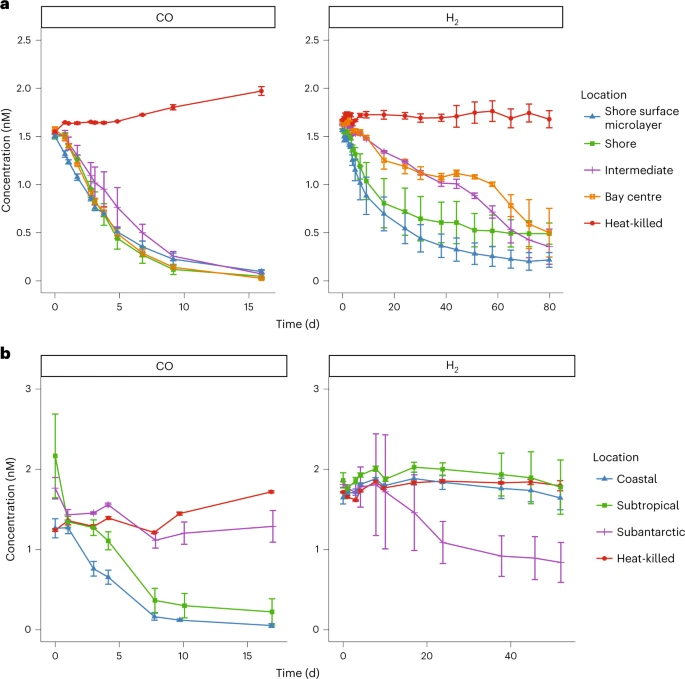2.7.23
Tania Ewing, Monash University
taniaewing@taniaewing.com
M: +61 (0)408 378 422
media@monash.edu
T: +61 (0) 3 9903 4840

Dr Rachael Lappan from Monash Biomedicine Discovery Institute
A world first study challenges the idea that the bulk of life in the ocean is fueled by photosynthesis via sunshine, revealing that many ocean microbes in fact get their energy from hydrogen and carbon monoxide.
It has always been a mystery as to how microbes growing in deepest parts of the sea survive, with no sunlight. A new study, from researchers at the Monash University published in the journal Nature Microbiology [below], shows that a distinct process called chemosynthesis – growth using inorganic compounds – fuels microbes in these darkest depths.
The five-year study, led by Dr Rachael Lappan and Professor Chris Greening from the Biomedicine Discovery Institute, reveals that two common gases – hydrogen and carbon monoxide – serve as the fuel for trillions of microbes in the ocean from the tropics to the poles.
Fig. 1: Ex situ oxidation of CO and H2 by seawater communities.

a,b, Results are shown for four samples in a transect at Port Phillip Bay, Victoria, Australia (a) and eight samples in the Munida transect off the coast of Otago, New Zealand (b). Each 120 ml sealed serum vial contained 60 ml of native seawater samples incubated in a 60 ml ambient-air headspace supplemented with ~2.5 ppmv H2 or CO. At each timepoint, the mixing ratio of each gas in the headspace of each vial was measured on a gas chromatograph and converted to dissolved gas concentrations (nM). Data are presented as mean ± s.e.m. of three biologically independent samples. Source data
According to Professor Greening, until now most scientists have believed that ocean microbial life is primarily driven by photosynthesis (growth by using light energy). “But what about those regions so deep that light can’t penetrate or so nutrient-poor that algae can’t thrive? We showed in this study that instead chemosynthesis is dominant in these regions,” he said.
“Hydrogen and carbon monoxide in fact “fed” microbes in all regions we’ve looked at: from urban bays to around tropical islands to hundreds of metres below the surface. Some can even be found beneath Antarctica’s ice shelves.”
The study involved combining chemical measurements during oceanic voyages with laboratory-based characterization of microbial cultures. The research team also extensively used metagenomic sequencing, “which tells us the genetic blueprints of all of the microbes present in a given region of the ocean,” Dr Lappan said. “We found the genes that enable hydrogen consumption across eight distantly related types of microbes, known as phyla, and this survival strategy becomes more common the deeper they live.”
For this project, the researchers were inspired by their previous work on soil bacteria. Professor Greening and colleagues have previously showed most soil bacteria can live by consuming hydrogen and carbon monoxide from the atmosphere.
“The surface layers of the world’s oceans generally contain high levels of dissolved hydrogen and carbon monoxide gases due to various geological and biological processes. So it made sense that oceanic bacteria used the same gases as their terrestrial cousins,” Dr Lappan said.
These findings provide insights into how life evolved. Professor Greening concludes that “The first life probably emerged in deep-sea vents using hydrogen and not sunlight as the energy source. It’s incredible that, 3.7 billion years later so many microbes in the oceans are still using this high-energy gas and we’ve completely overlooked this until now.”
See the full article here .
Comments are invited and will be appreciated, especially if the reader finds any errors which I can correct. Use “Reply”.
five-ways-keep-your-child-safe-school-shootings
Please help promote STEM in your local schools.
Monash University (AU) is an Australian public research university based in Melbourne, Australia. Founded in 1958, it is the second oldest university in the State of Victoria. Monash is a member of Australia’s Group of Eight and the ASAIHL, and is the only Australian member of the influential M8 Alliance of Academic Health Centers, Universities and National Academies. Monash is one of two Australian universities to be ranked in the The École des Mines de Paris (Mines ParisTech) ranking on the basis of the number of alumni listed among CEOs in the 500 largest worldwide companies. Monash is in the top 20% in teaching, top 10% in international outlook, top 20% in industry income and top 10% in research in the world in 2016.
Monash enrolls approximately 47,000 undergraduate and 20,000 graduate students, It also has more applicants than any university in the state of Victoria.
Monash is home to major research facilities, including the Australian Synchrotron, the Monash Science Technology Research and Innovation Precinct (STRIP), the Australian Stem Cell Centre, 100 research centres and 17 co-operative research centres. In 2011, its total revenue was over $2.1 billion, with external research income around $282 million.
The university has a number of centres, five of which are in Victoria (Clayton, Caulfield, Berwick, Peninsula, and Parkville), one in Malaysia. Monash also has a research and teaching centre in Prato, Italy, a graduate research school in Mumbai, India and a graduate school in Jiangsu Province, China. Since December 2011, Monash has had a global alliance with The University of Warwick (UK). Monash University courses are also delivered at other locations, including South Africa.
The Clayton campus contains the Robert Blackwood Hall, named after the university’s founding Chancellor Sir Robert Blackwood and designed by Sir Roy Grounds.
In 2014, the University ceded its Gippsland campus to Federation University (AU). On 7 March 2016, Monash announced that it would be closing the Berwick campus by 2018.


